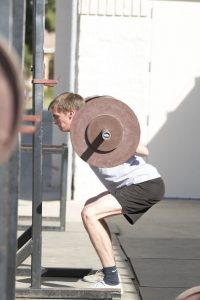If you aim at nothing, you will hit it every time.
I watched a short strength training video the other day (yeah, that’s what I do in my free time) about the importance of setting and pursuing goals for training. The presenter, Brooke Haubenstricker, of Starting Strength Online Coaching™, a strength training and education company, talked about the relationship between training and goals.

She described the key difference between exercise and training this way: “Goals drive our training and separate us from the exercisers because they give our physical activity purpose.” Ms. Haubenstricker went on to explain a process for setting goals that she uses with her coaching clients.
It is a well established approach, known as SMART goals, first described by management expert George Doran, in the November 1981 issue of the journal Management Review. The SMART acronym stands for a set of guiding principles that may be used to create goals for any aspect of life. The concepts encapsulated in the SMART approach are as follows: Specific, Measurable, Attainable, Realistic/Relevant and Timely.
An effective, useful goal will reflect each of those components. It will articulate both a target and a plan to hit the target. I first learned about the SMART goals approach from a colleague many years ago.
I have used it in coaching and teaching ever since. Ms. Haubenstricker’s video was a good reminder of how important it is to think deeply and critically about what we want to achieve so we can increase the likelihood of success.
Here is a brief summary of the SMART goal approach with some concrete examples of how to structure the goals.
Specific–a clear, precise statement of what you want to achieve
“I want to get 25-35% stronger in all four of the big lifts.” My goals are specific to strength and training can be oriented toward the goals efficiently.
Measurable–something that can be quantified, ideally with a number, so that progress toward the goal can be measured and observed over time.
Matthew Peterson, ‘20, breaks his squat personal record lifting 365 pounds during strength and conditioning, May 16.
“I want to reach the following strength benchmarks: a 400 lb deadlift, 325 lb squat, 300 lb bench press and 225 lb overhead press.” Those are numbers are absolute values and my current abilities as well as my progress can be measured against them.
Matthew Peterson, ‘20, breaks his squat personal record lifting 365 pounds during strength and conditioning, May 16. @fresnochristian #TheFeather pic.twitter.com/ouXoA9v33Q
— The Feather Online (@thefeather) May 16, 2018
Attainable–the goal must be something that is actually possible to accomplish (not like “I want to be the first person to walk on Saturn”).
Those benchmarks listed above have been reached by thousands of people so they are attainable.
Realistic or Relevant–something that is actually within one’s physical/mental capacity and pertains directly to one’s values and priorities.
The benchmarks I have identified are within the capacity of someone my age and with my physical attributes and limitations. Others like me have accomplished similar goals. They also correspond to my overall value system, interest in fitness and priority of personal challenge and growth.

Timely–there should be a deadline attached to the goal which incorporates an incentive for progress as well as a standard for completion.
“I want to achieve these goals within three years.” It is not so soon as to be un-achievable but not so distant that it lacks an element of urgency or challenge.
Using the SMART goals approach provides a framework for understanding where I currently am, identifying where I want to go and drawing the road map for how I will get there. Without goals, I have no way of knowing if I am making progress.
Goals determine how I train and how I organize my life to maximize my potential. The goals I identified in the the previous paragraphs are the basis for how I will structure my training program.
I will have to continually perform those movements with ever-increasing weight on the bar. I will have to eat enough and rest enough to recover and promote muscle protein synthesis and growth.
I will have to motivate myself to train through various obstacles, such as boredom, discomfort and life stress. In the end, if I am diligent, the process of establishing and pursuing those smart goals will make me a more functional human.
To read the latest Blog read: Functional Human Blog No.9 Competition. To read the first blog read: Functional Human blog, No.1.








Mark Pimentel • Feb 22, 2019 at 12:08 pm
This was an interesting article to read. I am going to use this in my workouts.
ryan • Feb 21, 2019 at 12:58 pm
I really enjoy working out with couch Fuller he really knows what he is doing. I feel like this article is a motivation to get people to get out of their house or if they aren’t doing anything to start working for something they want. Like me, if I wasn’t working out I wouldn’t feel good. But I am and that helps a lot with my motivation.
Carston • Feb 21, 2019 at 12:56 pm
Awesome stuff Coach Fuller!
Kayden Marquez • Feb 21, 2019 at 12:54 pm
Great article coach Fuller!
Macy Little • Feb 21, 2019 at 12:48 pm
Really enjoyed this article! very interesting to read, great job!
Reece Trevino • Feb 15, 2019 at 1:28 pm
Very interesting article, I like it!
Wesley Hinton • Feb 15, 2019 at 8:18 am
This was an interesting read. Awesome job coach Fuller!
Arundeep Singh • Jan 25, 2019 at 12:01 pm
Amazing Article Coach Fuller
Mark Pimentel • Jan 25, 2019 at 12:00 pm
I like this article it was interesting.
Arundeep Singh • Jan 25, 2019 at 12:00 pm
Amazing Article Coach Fuller.